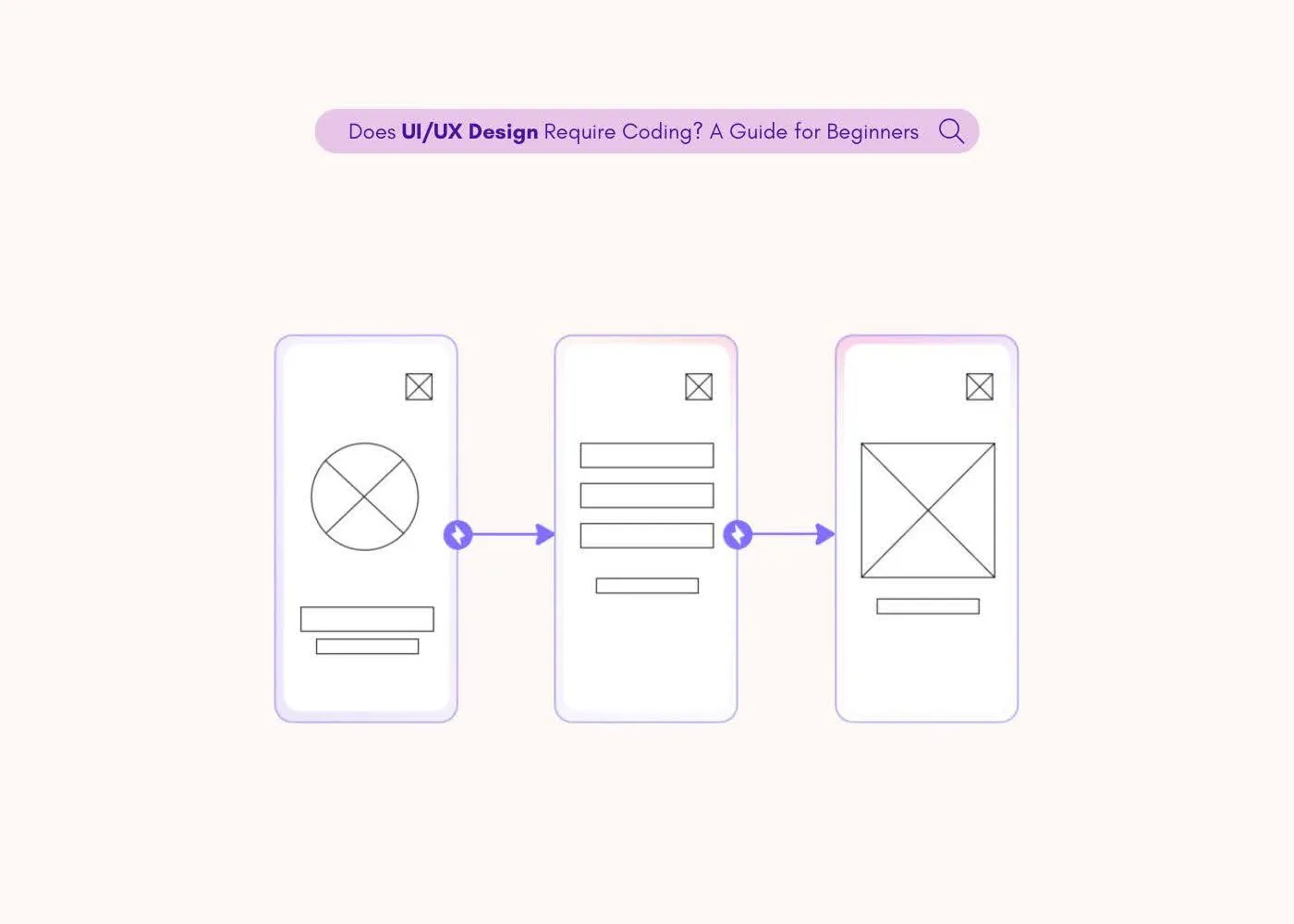The UI/UX Career Question Everyone Asks
When stepping into the world of UI/UX design, there’s one question almost every beginner asks: do UX designers need to learn coding? It’s a fair concern—many job descriptions mention HTML, CSS, or JavaScript, leaving aspiring designers wondering, does UI UX designer need coding skills to succeed? The truth is, the line between design and development can seem blurry, especially for those transitioning into tech from non-technical backgrounds.
Over the years, however, the answer to does UX design require coding has changed. With the rise of powerful no-code design tools and better team collaboration, designers can focus more on solving user problems and crafting great experiences—without writing a single line of code. That said, some knowledge of how digital products are built can be a plus.
This article offers a clear, realistic answer to the classic question: do I need to know coding for UI UX design? Whether you’re just getting started or considering a career switch, we’ll break down what truly matters in today’s design landscape—and help you decide if learning to code fits into your path.
Does UX Design Require Coding?
Quick Answer: No, coding is not required for UX design, but having a basic understanding of it can open more doors, depending on your career goals. The good news? You don’t need to be a coder to thrive in UI/UX. In fact, some of the best designers in the industry have built impressive careers without ever touching a line of code. So, does UX design require coding to get started? Absolutely not.
Modern design tools like Visily allow you to design, prototype, and test user experiences with zero coding knowledge. That means if you’re asking, do I need to know coding for UI UX design? the answer is a reassuring no.
Today’s design roles are increasingly specialized. In most cases, your strengths in user research, wireframing, interaction design, and solving real user problems will matter much more than your ability to write code. Employers now value designers who deeply understand user needs and translate them into intuitive, elegant interfaces.
However, the conversation shifts a bit when we talk about career flexibility and growth. For certain roles especially in startups or small teams having technical skills can be a big plus. So, if you’ve ever wondered, does UI UX designer need coding to stand out in a competitive job market, the answer is: it depends on your path.
Some UX roles that blend into front-end development or require close collaboration with developers may benefit from basic knowledge of HTML, CSS, and JavaScript. That brings up another common question: what coding languages do UX designers use? While not mandatory, these three are the most relevant for designers wanting to bridge the gap between design and development.
So, does UX design involve coding? Not by default but understanding how digital products are built can help you communicate better with developers, improve handoffs, and even prototype more effectively.
When Knowing Code Can Be A Bonus?
While not essential, coding knowledge offers advantages in certain design scenarios:
Working closely with developers
Understanding basic code principles helps tremendously when collaborating with development teams. When you grasp fundamental coding concepts, you’ll communicate more effectively about technical constraints and possibilities.
Many UX designers report that knowing what happens “behind the scenes” helps them design more realistic solutions and speak developers’ language.
Do you need to know coding for UX design to collaborate effectively? No, but it certainly smooths the process.
Designing developer-friendly interfaces
Designers with coding knowledge often create interfaces that implement more smoothly. You’ll anticipate potential development challenges and design accordingly.
Understanding how different interface elements translate into code makes you valuable in organizations where design and development work closely together.
Creating high-fidelity prototypes
Some prototyping situations benefit from basic coding skills. Interactive prototypes sometimes require custom animations or interactions beyond standard tool capabilities. Knowledge of HTML, CSS, and basic JavaScript enables you to create more sophisticated prototypes when needed.
Design Tools That Let You Work Without Coding
The good news for aspiring designers is that modern design tools have eliminated most coding requirements from the design process. Today’s software focuses on visual interfaces, drag-and-drop functionality, and code-free prototyping.
Visily stands out as the premier option for designers who want professional results without coding knowledge. As an AI-powered UI design platform, Visily removes technical barriers through intuitive interfaces and smart features.
The platform’s wireframing tool allows anyone to create professional wireframes without technical expertise.
What sets Visily apart is its comprehensive component library featuring pre-built UI elements that simply work. You’ll drag and drop components rather than coding them from scratch. The AI features even transform text descriptions into editable designs, further eliminating technical requirements.
For beginners concerned about what coding languages UX designers use, Visily removes this concern entirely. The platform handles technical details behind the scenes while you focus on design principles and user experience. Other modern design tools also provide no-code functionality, but often come with steeper learning curves or more complex interfaces.
For a more comprehensive look at beginner-friendly options, check out our guide to drag-and-drop wireframe tools and top UI wireframe tools for non-designers.
Final Thoughts
The UI/UX design field welcomes professionals from diverse backgrounds. Coding knowledge provides advantages in certain contexts but isn’t a prerequisite for success. Focus first on developing strong design fundamentals, understanding user psychology, and mastering visual communication principles.
If you’re interested in creating interactive prototypes, our guide to creating low and high-fidelity prototypes offers valuable insights without requiring coding knowledge.
Modern tools like Visily have democratized design, making it accessible to anyone with visual thinking skills and a desire to create better user experiences. Your success ultimately depends not on coding abilities but on your design thinking, empathy for users, and commitment to creating intuitive, delightful digital experiences.
FAQs
Do UX designers need to learn coding?
No, UX designers don’t absolutely need to learn coding to succeed. While basic familiarity with HTML, CSS, or JavaScript can be helpful for collaboration with developers, modern design tools like Visily eliminate the need for coding knowledge. Focus instead on mastering core design principles, user research methods, and visual communication skills.
Does UI/UX design require coding for high-paying jobs?
Most high-paying UI/UX positions emphasize design expertise rather than coding skills. Employers value designers who create exceptional user experiences, understand business objectives, and communicate effectively. Some specialized roles or tech-focused companies may prefer candidates with technical knowledge, but coding is rarely the primary requirement for well-compensated design positions.
What coding languages do UX designers use when coding is necessary?
When UX designers do use coding, they typically work with front-end languages like HTML, CSS, and JavaScript. HTML structures content, CSS handles styling, and JavaScript adds interactivity. Some designers also learn frameworks like React or Angular for more advanced prototyping. However, most designers rely on specialized design tools rather than writing code directly.
Is coding required for UX design in startups vs. large companies?
Startups often prefer versatile team members who can handle multiple responsibilities, potentially including basic coding. Large companies typically have more specialized roles where designers focus exclusively on design without coding requirements. Your specific work environment may influence how much coding knowledge proves beneficial.
Do I need to know coding for UI/UX design if I want to create prototypes?
No, modern prototyping tools like Visily allow you to create sophisticated, interactive prototypes without writing code. These tools offer drag-and-drop interfaces and pre-built components for creating functional prototypes. While coding knowledge might help with extremely custom interactions, the vast majority of prototyping needs can be met without coding skills.








